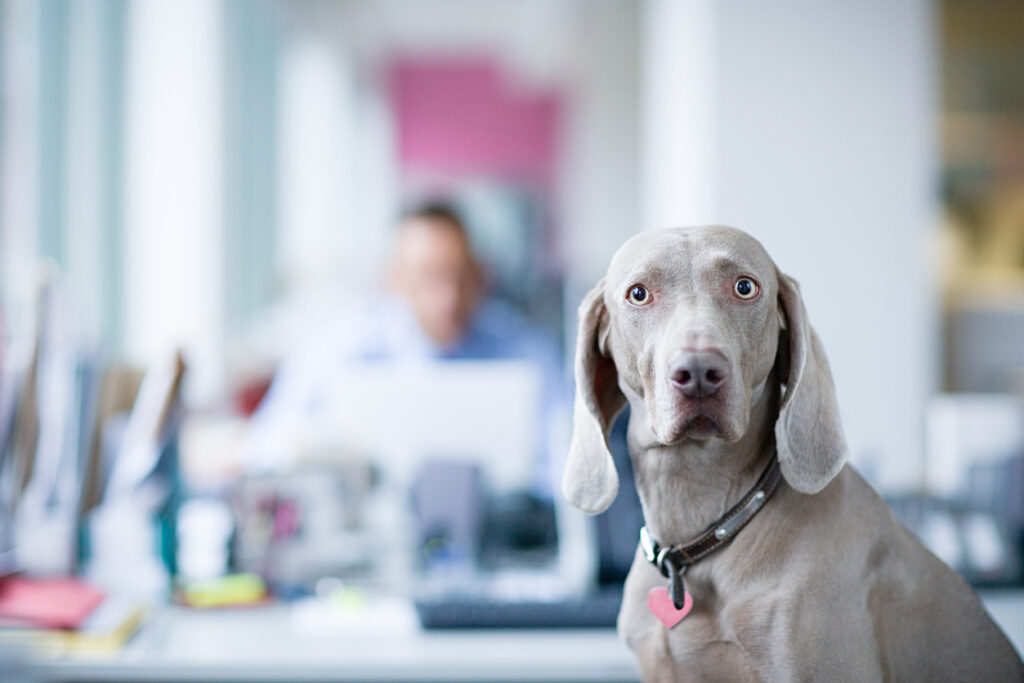There’s been much discussion over the last two years about how the world of work has changed – many organisations have now embraced hybrid working and there’s a much greater emphasis on employee wellbeing than ever before. What you may not have discussed, in a work context at least, is the increase in pet ownership.
Pets aren’t just good for morale – they can also be beneficial to your health
Pandemic pets
Last year the PFMA calculated that 3.2 million households had taken in a pet since the start of the pandemic, and there are around 12 million pet dogs in the UK. Many of your employees will now have additional furry members of their families who need care and attention and, as well as the practical considerations of having to look after them during the working day, there are also the wellbeing benefits that come with having their pets around at work.
Pets aren’t just good for morale – they can also be beneficial to your health. In our recent Paws For Thought survey, more than 70% of people who responded to our survey who had suffered from mental health issues including depression and anxiety said that having a pet helped to alleviate their condition. The same number who suffered from physical health conditions said owning a pet – and the exercise that comes with it – improved their symptoms also.
So, there’s widespread agreement that having pets is a good thing and that bringing them to work can help improve conditions for not just the pets, but also the owners and even possibly their colleagues, too. If this is something your employees are keen to do, there are some key considerations employers need to make to ensure it’s a success for everyone.
1. Is everyone dog friendly?
It may seem obvious, but it’s important to check first of all if there are any team members who might be allergic to dogs or afraid of them. No one wants their pet’s presence to negatively impact their colleagues. If there are colleagues who would not welcome the addition of a pet to their office environment, there are things you can do to accommodate both parties – for example, hybrid working arrangements may allow for those with pets to be in at a different time to their colleagues, or separating the workspaces with baby gates can work in some situations. It’s important, however, that all parties are consulted before the arrangements are put in place.
When assessing risks, try to see it from a dog’s point of view – cable cords and rubbish bins can be hazardous
2. Are other dogs there?
If several team members are planning to bring their dogs into the office, it might be worth coming up with a rota system to make sure not too many dogs are in at the same time; also, not all dogs get along with each other, so introductions need to be made carefully if you are planning to have more than one dog in at once.
3. A dog’s eye view
Health and safety is, of course, critical for any visitors coming to your office, and that includes furry ones. When assessing risks, try to see it from a dog’s point of view – cable cords and rubbish bins can be hazardous for pets, so you’ll want to limit their access to these.
4. Have a poo plan
It’s important to have a plan in place for where they’re going to be toileting – is there an easily accessible garden or walk they can be taken on to relieve themselves if needed? Are there spare dog poo bags available in case colleagues forget to bring them? We’d also recommend having a ‘clean up kit’ accessible to owners in case of any accidents in the office and making sure that owners understand it is their responsibility to clean up after their pet. (Non-ammonia-based products are best to take away the scent and reduce the likelihood of the dog using the same spot again).
5. Chip and check
It is a legal requirement to ensure your dog is microchipped, and if you’re taking them into the office it’s worth double checking that your contact details are up to date, just in case your furry friend does happen to take an unexpected walkies in an unfamiliar place without you. If you’re going to have a policy on bringing dogs into the office, it should also require that all dogs are healthy and up to date with their vaccinations, so they don’t potentially spread any infections.
Most dogs will feel more secure if they can stay close to their owners, so have a space where their bed and favourite toys are near to the owner’s desk
6. Finding a safe space
Most dogs will feel more secure if they can stay close to their owners, so having a space where their bed and favourite toys can be placed that is near to the owner’s desk is ideal. It’s also worth considering what your policy is on their movements around the building – ideally, they would be able to accompany their owner into other areas of the office such as meeting rooms, but if this is not permitted, you’ll need a plan as to how and where the dog will be kept when its owner is not present.
If, for example, the owner has to go into a meeting and the dog isn’t allowed in that room, do you need baby gates to keep them in their area? Will there be someone who can keep an eye on the dog and keep it company until the owner comes back? Working through these scenarios with colleagues in advance can help save a lot of trouble in the long run.
7. Try a trial day
Finally, remember that as with many employee policies, there’s a degree of consultation that needs to happen before you can successfully implement it. It might be that you need to run a trial day – or several – before you get the formula right. With the right plans in place, however, and all your team on board, having dogs in your workplace can be a wonderful boost for your employees and make your business a more ‘pawsome’ place to work!
Interested in this topic? Read Office dogs: The pros and cons.
[cm_form form_id=’cm_65a14c3f5da64′]






